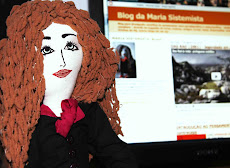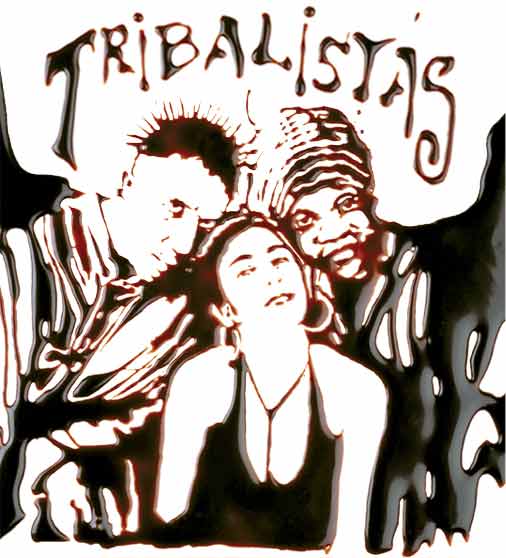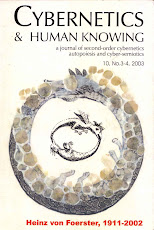BOOK: CYBERNETICS & HUMAN KNOWING - A Journal of Second-Order Cybernetics, Autopoiesis & Cyber-SemioticsVol. 12, No. 1-2, 2005
GREGORY BATESON [1904-1980], Essays for an Ecology of IdeasCONTENTS (sumário) Frederick Steier and Jane Jorgenson(Both from the Department of Communication, University of South Florida)
Frederick Steier and Jane Jorgenson(Both from the Department of Communication, University of South Florida)Foreword: Patterns That Connect Patterns That Connect
Mary Catherine Bateson(President, Institute for Intercultural Studies, New York; and Professor Emerita George Mason University, Fairfax, Virginia)The Double Bind: Pathology and Creativity
Will McWhinney(Institute for the Study of Transformative Education)The White Horse: A Reformulation of Bateson's Typology of Learning Appreciation of Difference
*** Figure 1: A Basic Cybernet for LI
A NEURO-PHYSIOLOGICAL MODEL
Orders of Learning and Change
Zero Order
First Order (LI)
Second Order (LII)
*** Figure 2: A Second Order CybernetThird Order (LIII)
Summary
ReferencesFrederick Steier(Department of Communication, University of South Florida)Exercising Frame Flexibility
Gregory Bateson reads Calvin and Hobbes
Designs for learning and play at a science center
Emergent themes
The message: This is character building , The message: This is learning, (and frames for frames).
Flexibility
Frame Flexibility
Exercising frame flexibility
ReferencesThomas Hylland Eriksen(University of Oslo/Vrije Universiteit Amsterdam)Mind and Gap: Flexibility, Epistemology and the Rhetoric of New Work Flexibility and rigidity
Some implications
Flexibility and new work
Acknowledgments
ReferencesPeter Harries-Jones(Department of Anthropology, York University, Ontario, Canada)Understanding Ecological Aesthetics: The Challenge Of Bateson 1. Introduction: Aesthetics and Ecology
2. Bateson's Move into Ecology
3. Why Aesthetics?: Bateson and Blake
4. J. M. Coetzee and the "True Challenge"
5. Suzi Gablik and the Re-enchantment Thesis
6. Abrupt Change and Free-fall
7. The Bateson Challenge in Angels Fear
ReferencesBradford Keeney(Distinghished Scholar of Cultural Studies, Ringing Rocks Foundation)A Kalahari Challenge to the Hegemony of Narrative
ReferencesDouglas Flemons(Professor of Family Therapy; Director, Brief Therapy Institute; Director, NSU Sudent Counseling, Nova South-eastern University)May the Pattern be With You
Connection/Separation
Relational Freedom
Concordance
Sentence as Story
Batesonian Invention
Acknowledgements
ReferencesThomas E. Malloy / Carmen Bostic St. Clair, and John Grinder(Department of Psychology, University of Utah / Quantum Leap)Model-based Intuitions about Emergence
Boolean Dynamic Systems***Figure 1: Camouflage-like striped patterns. The first four columns (a to d) are four basins from the same dynamic system. The fifth column (e) is a basin from a different dynamic system.
Critiques of Emergence
Intuition as a Legitimate Methodology
The Embodiment of Mind
That a Human May Know It***Figure 2: Four basins from a pseudo-randomly generated dynamic system. Panels (a) and (b) are perceived as similar as are panels (c) and (d).
Dynamic Constancies for Differences in Differences over Time
Emergent Hierarchies in Model and Perception***Figure 3: Dynamic Constancy. Six visual forms placed into three categories based ou identical first derivatives. The three categories are themselves placed into two meta-categories based on identical second derivatives.
The Human Reference Point
What is Human Knowledge that a Human May Know Dynamic Systems?
Critical Concerns Revisited
Emergence as Metaphor
Steps to an Ecology of Emergence
References
AppendixKenneth N. Cissna / and Rob Anderson(Department of Communication, University of South Florida, Tampa, Florida / Department of Communication, Saint Louis University, St. Louis, Missouri)Background to the Dialogue
The "Bloody Hot" Evening and its Conversation
A Structure for Extending and Distinguishing Ideas in Public Dialogue
Distinction and Extension in the Bateson-Rogers Dialogue
Reclaiming the Reputation of the Bateson-Rogers Dialogue
ReferenceWendy Leeds-Hurwitz(Communication Department, University of Wisconsin-Parkside, Kenosha, Wisconsin)The Natural History Approach: A Bateson Legacy Development of the Natural History Approach
Spread of the Natural History Approach
Application of the Natural History Approach
Conclusion
ReferencesAlfonso Montouri(California Institute of Integral Studies, San Francisco, California)Introduction
Homeless: Some Personal Context
Towards Transdisciplinary Inquiry
Cornerstones of Transdisciplinarity
The Journey Home
References
Column: Louis H. Kauffman(Math Department, University of Illinois-Chicago, Chicago, Illinois)Virtual Logic - The One and the Many
I. Introduction
II. On Sets
III. The Strange Case of the Singleton Set
IV. David Lewis on Singletons
V. Notes on Physical Reality
VI. Epilogue
ReferencesASC Pages: Peter Harries-Jones(Department of Anthropology, York University, Ontario, Canadá)The ASC Meeting, Toronto
Recursion: Digital, Analogue or Both?
Finding a Suitable Topology for Heterarchy
ReferencesBook Reviews: Ranulph Glanville(CybernEthics Research, Southsea, United Kingdom)International Encyclopaedia of Systems and Cybernetics, second edition Improvement?
Buying?
References
 28.02.2010 - Morte e continuidade de um dos maiores bibliófilos brasileiros. José Mindlin continua na continuação da sua paixão pela democratização do acesso ao livro no Brasil, e em cada um dos 45.000 volumes que doou para a (sua) Biblioteca Brasiliana Guita e José Mindlin, na USP. Ele que sempre defendeu a abertura de mais bibliotecas públicas em nosso País, espaços que, como a internet, deveriam ampliar o acesso aos livros funcionando também à noite, aos Sábados, Domingos e feriados. Neste BLOG fica um abraço virtual de terno agradecimento e profundo respeito.
28.02.2010 - Morte e continuidade de um dos maiores bibliófilos brasileiros. José Mindlin continua na continuação da sua paixão pela democratização do acesso ao livro no Brasil, e em cada um dos 45.000 volumes que doou para a (sua) Biblioteca Brasiliana Guita e José Mindlin, na USP. Ele que sempre defendeu a abertura de mais bibliotecas públicas em nosso País, espaços que, como a internet, deveriam ampliar o acesso aos livros funcionando também à noite, aos Sábados, Domingos e feriados. Neste BLOG fica um abraço virtual de terno agradecimento e profundo respeito.






















